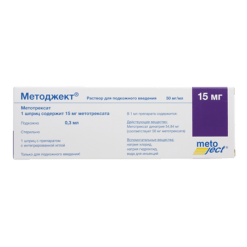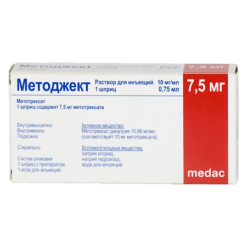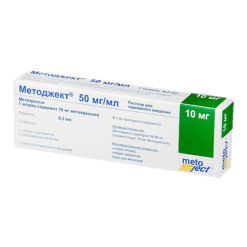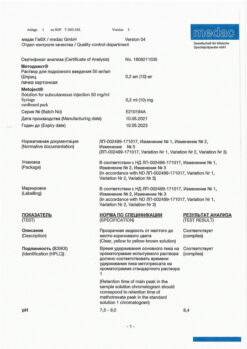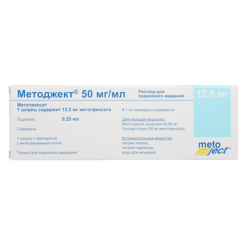No products in the cart.
Description
Antitumor, cytostatic agent of antimetabolite group, inhibits dihydrofolate reductase involved in the reduction of dihydrofolic acid to tetrahydrofolic acid (carrier of carbon fragments necessary for the synthesis of purine nucleotides and their derivatives).
Inhibits synthesis, DNA repair and cellular mitosis. Especially sensitive to its action are rapidly proliferating tissues: cells of malignant tumors, bone marrow, embryonic cells, epithelial cells of intestinal mucosa, urinary bladder, oral cavity. Along with anti-tumor effects it has immunosuppressive effects.
Pharmacokinetics
The absorption when taken orally depends on the dose: At 30 mg/m2 administration, absorption is good; average bioavailability is 60%. Absorption is reduced at doses greater than 80 mg/m2.
In children with leukemia, absorption ranges from 23% to 95%. Time to reach Cmax is 40 min to 4 h. Food slows absorption and reduces Cmax. The binding to plasma proteins is about 50%, predominantly to albumin.
After distribution in the tissues, high concentrations of methotrexate in the form of polyglutamates are found in the liver, kidneys and especially in the spleen, where methotrexate may be retained for several weeks or even months.
When taken in therapeutic doses, it practically does not penetrate through the blood-brain barrier. It penetrates into the breast milk.
After oral administration it is partially metabolized by the intestinal flora, the main part – in the liver (regardless of the route of administration) to form the pharmacologically active polyglutamine form, which also inhibits dihydrofolatoreductase and thymidine synthesis. T1/2 in patients receiving less than 30 mg/m2 of the drug is 2-4 h in the initial phase and 3-10 h in the final phase (which is prolonged) with low and 8-15 h with high doses of the drug. In chronic renal failure both phases of drug excretion may be significantly prolonged.
The drug is excreted mainly by kidneys unchanged by glomerular filtration and tubular secretion, about 10% is excreted in bile (with subsequent reabsorption in intestine). Excretion of the drug in patients with impaired renal function, marked ascites or transudate is significantly delayed. When repeated administration it accumulates in tissues as polyglutamates.
Indications
Indications
Active ingredient
Active ingredient
Composition
Composition
Active substances:
Methotrexate 2.5 mg
How to take, the dosage
How to take, the dosage
Intramuscularly or intravenously.
In the treatment of acute lymphoblastic leukemia, 20-30 mg/m2 in/m 2 times a week. Alternatively, 2.5 mg/kg v/v every 14 days.
The usual dose in the treatment of choriocarcinoma is 15-30 mg/m2 daily for 5 days. Such courses may be repeated 3 to 5 times as needed, with treatment intervals of 1 week or more. For palliative treatment of inoperable solid tumor, 25-50 mg/m2 weekly by injection.
In acute lymphoblastic leukemia, remission was achieved when 20-40 mg/m2 was administered twice weekly by IV or IM injection. Maintenance therapy dose was 15-30 mg/m2 body surface 1 or 2 times a week w/v or w/v.
Interaction
Interaction
Increased and prolonged action of methotrexate, leading to intoxication, contributes to the simultaneous use of NSAIDs, barbiturates, sulfonamides, corticosteroids, tetracyclines, trimethoprim, chloramphenicol, paraaminobenzoic and paraaminohippuric acids, probenecid. Folic acid and its derivatives reduce the effectiveness. It increases the effect of indirect anticoagulants (coumarin or indandion derivatives) and increases the risk of bleeding. Drugs of penicillin group decrease renal clearance of methotrexate.
The simultaneous use of methotrexate and asparaginase may block the effect of methotrexate. Neomycin (oral) may reduce absorption of methotrexate (oral). Drugs that cause pathological changes in the blood increase leukopenia and/or thrombocytopenia if these drugs have the same effect as methotrexate on bone marrow function.
Other drugs that cause suppression of bone marrow function or radiation therapy potentiate the effect and additively suppress bone marrow function. Synergistic cytotoxic effect with cytarabine is possible with concomitant use.
Concomitant use of methotrexate (intrathecal) with acyclovir (parenterally) may cause neurological disorders. In combination with live viral vaccines may cause intensification of the replication process of the vaccine virus, increased vaccine side effects and reduced antibody production in response to the administration of both live and inactivated vaccines.
Special Instructions
Special Instructions
Conception should be avoided during methotrexate treatment and after it (men – 3 months after treatment, women – at least one ovulation cycle). After treatment with methotrexate the use of calcium folinate is recommended to reduce the toxic effects of high doses of the drug.
The necessary rules for use and destruction of the drug should be observed.
Contraindications
Contraindications
The use of methotrexate is contraindicated in pregnancy and during lactation, with marked changes in renal and liver function, hematological disorders (such as bone marrow hypoplasia, leukopenia, thrombocytopenia, anemia), in the acute phase of infectious diseases, immunodeficiency syndrome, hypersensitivity to methotrexate or other components of the tablet, children under 3 years old.
With caution. In ascites, pleural effusion, gastric and duodenal ulcer, ulcerative colitis, dehydration, history of gout or nephrolithiasis, previous radiation therapy or chemotherapy, infectious diseases of viral, fungal or bacterial nature.
Side effects
Side effects
Blood system disorders: anemia (including aplastic), thrombocytopenia, leukopenia, neutropenia, agranulocytosis, eosinophilia, pancytopenia, lymphoproliferative diseases, hypogammaglobulinemia, lymphadenopathy.
Digestive system disorders: Anorexia, nausea, vomiting, stomatitis, gingivitis, pharyngitis, enteritis, erosive ulcerative lesions and bleeding from the GI tract (including melena, hematemesis), hepatotoxicity (acute hepatitis, liver fibrosis and cirrhosis, liver failure, hypoalbuminemia, increased activity of “liver” transaminases), pancreatitis.
Nervous system disorders: headache, dizziness, somnolence, dysarthria, aphasia, hemiparesis, paresis, convulsions; when used in high doses – transient cognitive impairment, emotional lability; unusual cranial sensitivity, encephalopathy (including leukoencephalopathy).
VIight: conjunctivitis, visual impairment (including transient blindness).
Cardiovascular system disorders: pericarditis, pericardial effusion, decreased BP, thromboembolism (including arterial thrombosis, cerebral thrombosis, deep vein thrombosis, retinal vein thrombosis, thrombophlebitis, pulmonary embolism).
Respiratory system disorders: rare – pulmonary fibrosis, respiratory failure, alveolitis, interstitial pneumonitis (including fatal), chronic obstructive pulmonary disease (COPD), symptoms of potentially serious interstitial pneumonia – dry non-productive cough, shortness of breath, fever.
Urogenital system disorders: severe nephropathy or renal failure, azotemia, cystitis, hematuria, proteinuria, impaired spermatogenesis and ovogenesis, transient oligospermia, decreased libido, impotence, dysmenorrhea, vaginal discharge, gynecomastia, infertility, miscarriage, fetal death, fetal development defects.
Skin disorders: erythematous rash, skin itching, urticaria, photosensitivity, skin pigmentation disorders, alopecia, ecchymosis, telangiectasia, acne, furunculosis, erythema multiforme (including Stevens-Johnson syndrome), toxic epidermal necrolysis, skin ulceration and necrosis, exfoliative dermatitis. In the treatment of psoriasis – a burning sensation of the skin, painful erosive plaques on the skin.
Musculoskeletal system: arthralgia, myalgia, osteoporosis, osteonecrosis, fractures.
Novoplasms: lymphoma (including reversible).
General reactions: Allergic reactions up to and including anaphylactic shock, allergic vasculitis, tumor lysis syndrome, soft tissue necrosis, sudden death, life-threatening opportunistic infections (including pneumocystis pneumonia), Cytomegalovirus (CMV) infections (including CMV pneumonia), sepsis (including fatal), nocardiasis, histoplasmosis, cryptococcosis, infections caused by Herpes zoster and Herpes simplex (including disseminated herpes), diabetes, excessive sweating.
Overdose
Overdose
Symptoms: no specific symptoms.
Treatment: immediate administration of calcium folinate to neutralize the myelotoxic effects of methotrexate (oral, intramural or intravenous). The dose of calcium folinate should be at least equal to the dose of methotrexate, and should be given within the first hour; subsequent doses should be given as needed. Increase hydration of the body, and carry out alkalinization of urine to avoid precipitation of the drug and its metabolites in the urinary tract.
Similarities
Similarities
Additional information
| Shelf life | 3 years |
|---|---|
| Conditions of storage | In a light-protected place at 15-30 °C. Keep out of reach of children. |
| Manufacturer | Valenta Farm, Russia |
| Medication form | pills |
| Brand | Valenta Farm |
Other forms…
Related products
Buy Methotrexate, tablets 2.5 mg, 50 pcs. with delivery to USA, UK, Europe and over 120 other countries.


